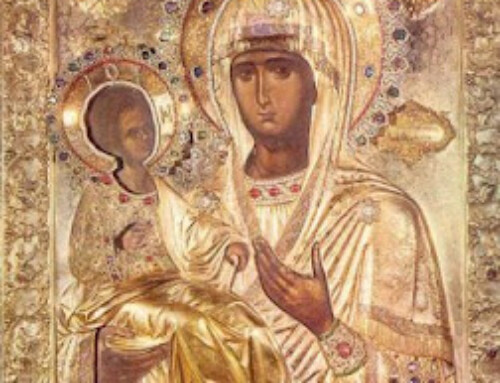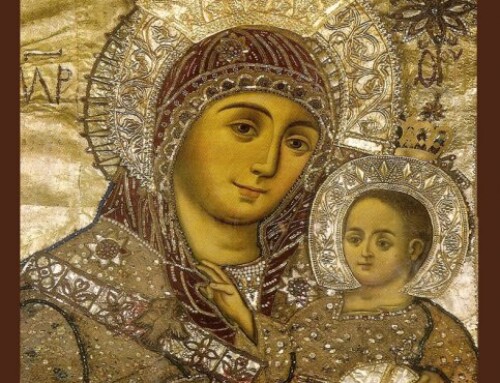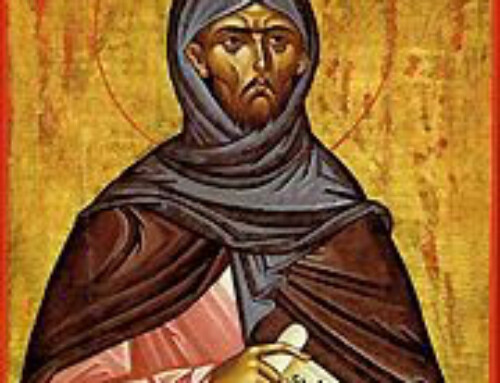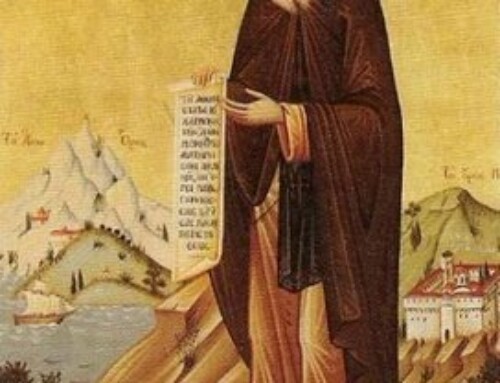 July 19th
July 19th
Theodore, Archbishop of Edessa
He was a terrible student – a fretful and daydreaming child who seemed unable to concentrate on anything. He was also full of mischief. One morning, for example, while the local Archbishop conducted services at the Holy Table, he hid beneath the table covering . . . and fell sound asleep!
He was only seven or eight years old at the time (around 790 A.D., according to most Church historians). But his life was about to be changed forever by a haunting and mysterious dream.
As the naughty boy slumbered beneath the Holy Table on that long-ago morning, he saw a beautiful child walking toward him. Light danced and shimmered around the tiny newcomer’s head – and when the youthful Theod

ore (the name means “Gift of God”) looked more closely, he saw that his friendly dream-visitor was holding out a gift.
It was a comb of fresh honey . . . a delightful treat that was obviously meant to strengthen and refresh the lad who dozed beneath the table. Theodore accepted the blessing happily, and was thoroughly startled when the smiling child suddenly spoke aloud to him.
Although the words were hard to make out at first, the dreaming youth soon began to understand them: The child who had brought the honey was asking Theodore to become a monk! Amazed by this request, the mischief-maker was even more startled to discover that the visitor was also carrying a wooden staff.
As he took this sacred implement from the brilliantly illuminated child, Theodore realized that such staffs usually served to identify bishops of the HolyChurch. Perplexed, he shook his head. This beaming child wanted him to become a monk; was he also destined to become a bishop, later in life?
He was. For the great monk and bishop St. Theodore, that remarkable incident beneath the table would provide the first chapter in a marvelously austere and ascetic life that would be totally devoted to the glory of Almighty God.
Born in the Mesopotamian city ofEdessa(today part of modernTurkey), the blessed St. Theodore was the long-awaited son of two pious Christians, Symeon and his deeply devoted spouse, Maria. For many years, these two residents of the ancient city had yearned for a son. And then a miracle had occurred. After a thrilling, shared vision in which the great teacherSt. Paulannounced that they would indeed have a boy (their “Gift of God,” Theodore), the faithful couple was overjoyed by the arrival of the infant around the year 785 A.D.
Endlessly grateful for the new arrival, the proud parents of Theodore were nonetheless alarmed by his poor performance at school. What in the world could be affecting his schoolwork in such a negative way? Like most parents, the distressed Symeon and Maria did everything they could to help the boy with his studies. Like his worried teachers, they were also greatly amazed – during the months that followed the child’s under-the-table dream of the staff-carrying visitor – when his schoolwork greatly improved . . . to the point that the youthful Theodore soon became the best student in his class, while eventually excelling in grammar, philosophy and rhetoric!
Apparently, the young man’s motivation had been enormously affected by the apparition of the honey-bearer, and he was now declaring that he wanted to become a holy monk and live in theHoly Land. Nor was this an idle whim. When his parents died within a few months of each other, the 18-year-old Theodore quickly took two steps that would dramatically change his life. First, he gave away his entire inheritance to the poor. Immediately after this decisive act, he set sail forJerusalem, intent on visiting (and venerating) the sacred shrines ofJerusalemand its environs to his heart’s content.
After spending many days in fervent prayer at such key shrines as Golgotha, the site of Christ’s Crucifixion, and Gethsemane (where Jesus had endured the Agony in the Garden), St. Theodore summoned up all his courage and paid a visit to the famed Monastery of St. Sabas the Sanctified, located near Jerusalem, where some of the most dedicated and spiritually advanced monks in the world then lived.
During his lengthy visit, the pious Theodore begged the Abbot of St. Sabas, the saintly John, for admission to the monastery. And when his wish was granted, he wept tears of joy. During the next few years, he would become a legendary figure whose self-denying asceticism was regarded as a model for aspiring monastics. While subsisting on a little bread and water each day, and while sleeping for only two hours a night (he preferred to stand up in his cell for most of the night, feverishly praying), this dedicated monk would learn the spiritual discipline of monasticism from the ground up.
After twelve years of depriving himself in this manner, St. Theodore was startled to learn that the great teacher and mentor Abbot John had died suddenly. His reaction was typical; since his greatest friendship in the monastery had now ended – his deep and profoundly affectionate relationship with the holy man, from whom he had learned so much – he decided to test himself by living the arduous and austere life of a desert monk. For the next 24 years, he would wander the wilds of the great Judean desert, often subsisting on nothing more than a few dates, or a handful of herbs each day.
During these remarkable years, the pious monk Theodore would own nothing more than a single ragged garment. And when other monk-aspirants approached him, begging for instruction, he would turn away in simply humility, convinced that he had nothing to teach them. On the one occasion when he did agree to instruct a candidate for the monastic life (a young nephew, named Michael, from the old world of Edessa, who had begged him for such guidance), the Venerable Theodore was saddened to later witness the youth’s brutal martyrdom at the hands of a vicious pagan king and queen.
Shaken and troubled by Michael’s bloody fate, St. Theodore wanted no part of spiritual authority in any form – which is why he was so alarmed when the Patriarch of Antioch and several of his colleagues decided, a few years later, that he was the perfect candidate to become the next Archbishop of Edessa! Although he explained again and again that he was a simple man who preferred to wander alone through the wild fastnesses of ruralPalestine, the Patriarch insisted and St. Theodore had no choice but to obey.
During the remaining years of his struggling life, this great Christian saint would survive many harrowing spiritual adventures. On one momentous occasion, for example, after being summoned to the bedside of the Persian King Muawid – then ruling inBabylon(today’s modernBaghdad) – the venerated Theodore would heal the monarch of a deadly cancer and then convert him to the one true faith of Jesus Christ. But alas, that great act of conversion also ended in great sorrow . . . after the Persian King, having been given the Christian name of John, was brutally martyred by his own pagan countrymen.
Once again, the humble Theodore had paid a high price for leaving his austere desert life and attempting to help a fellow human being to accomplish a life-changing conversion. Yet the holy saint’s struggles were far from over; on three different occasions, he would also be required as Archbishop to fiercely contend against dangerous heresies (those of the Nestorians, the Manicheans and the Severians).
His endless efforts were ultimately successful, however. After many years of struggle, St. Theodore could rest secure in the knowledge that the heresies had been overcome, and that the one true faith of theHolyChurchwould remain untainted by them, far down into the future. When the old man finally died at the age of about 65 – inEdessa, and in the Year of Our Lord 848 – he was mourned by Christians throughout the great city as a tireless servant of the Holy Redeemer, Jesus Christ.
In the end, his boyhood dream of the child with the honey and the bishop’s staff guided him well on the long road to eternal salvation. Today, more than a thousand years after he struggled so hard to obey the will of his Heavenly Father, the blessed St. Theodore is still revered as a wondrous model of fidelity to Almighty God.
Apolytikion in the Eighth Tone
Guide of Orthodoxy, teacher of piety and purity, luminary of the world, God-inspired adornment of hierarchs, O most wise Theodore, by thy teachings thou hast enlightened all, O harp of the Spirit. Intercede with Christ God that our souls be saved.
Kontakion in the Third Tone
From the blessedEdessa, thou wentest forth to the desert, but thou wast called back again to tend Christ’s sheep as their shepherd; driving off the wolves of error with thy true doctrines, thou didst make a heathen king a Martyr of Jesus. Hence, O Theodore, we honour thy blest remembrance, O holy Hierarch of Christ.





